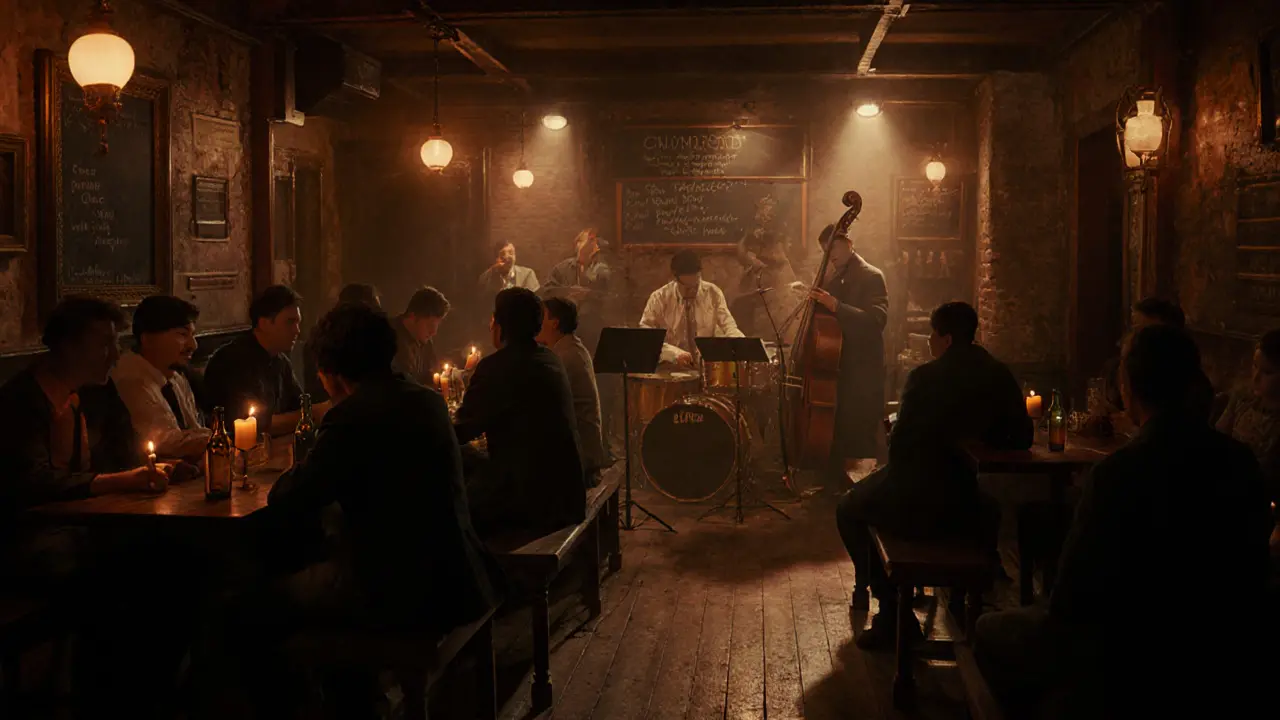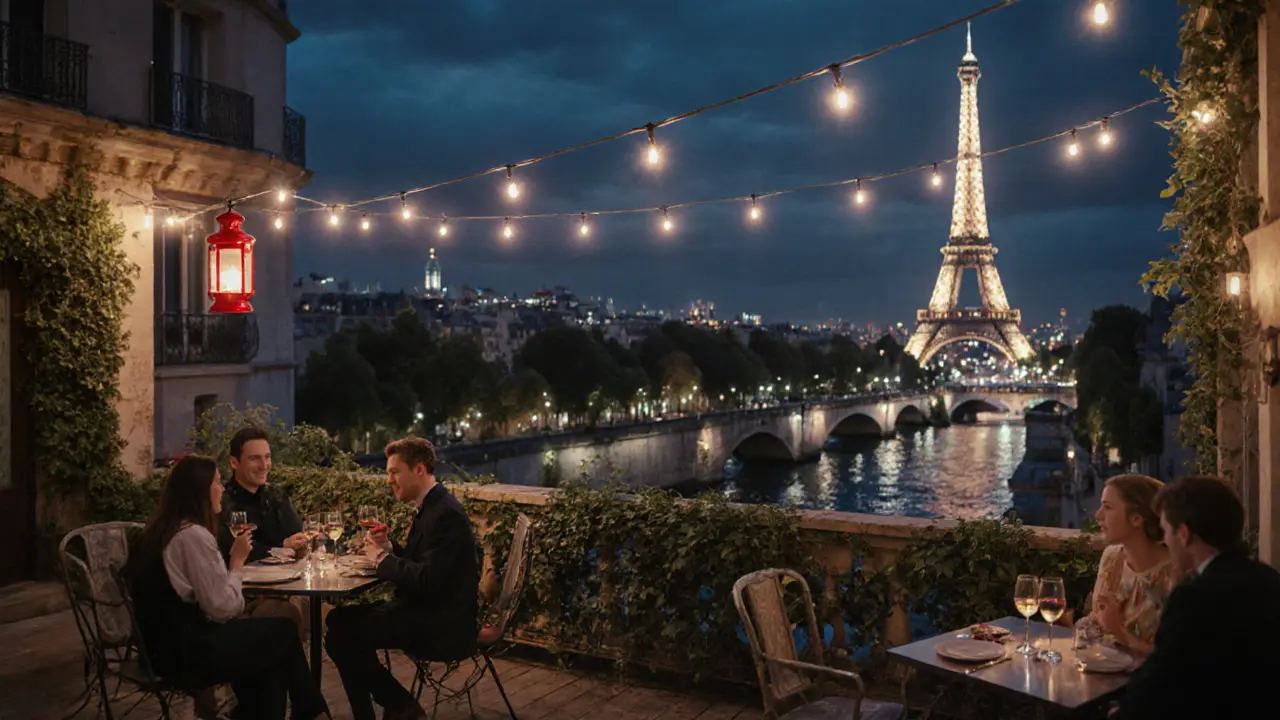Paris After Dark: The Ultimate Cultural Guide to Nightlife in the French Capital

Paris doesn’t sleep when the sun goes down-it transforms. The city’s nightlife isn’t just about drinking or dancing. It’s about hidden jazz cellars where the music feels like it’s been carved from the walls, candlelit wine bars where strangers become friends over a bottle of Beaujolais, and rooftop terraces that turn the Eiffel Tower into a glittering postcard you can almost touch. This isn’t the Paris of tourist brochures. This is the Paris that wakes up after midnight.
The Soul of Parisian Nightlife: More Than Just Bars
Forget the idea that nightlife means loud music and crowded clubs. In Paris, the night is layered. It starts with aperitif hour around 8 p.m., when locals gather at sidewalk cafés with a glass of pastis or a crisp white wine. By 10 p.m., the energy shifts. People move to smaller venues-places without signs, where the only clue you’re in the right spot is the line of people quietly chatting outside a nondescript door.
Take Le Caveau de la Huchette in the Latin Quarter. This cellar bar has been playing live jazz since 1947. No neon lights. No cover charges. Just a 12-piece band, wooden benches, and a floor that’s worn smooth by decades of dancing. You won’t find a menu with cocktails named after Instagram trends. You’ll find a chalkboard listing the night’s setlist and a wine list that hasn’t changed since the 1980s. That’s the rhythm of Paris after dark-timeless, unbothered by trends.
Where to Find the Real Nightlife: Neighborhood Guides
Paris isn’t one nightlife scene. It’s a dozen, each with its own heartbeat.
Le Marais is where creativity meets culture. By 11 p.m., you’ll find young artists, designers, and writers spilling out of Bar des Phares, a tiny spot with mismatched chairs and walls covered in Polaroids of past patrons. The drinks are cheap, the conversations are deep, and the playlist jumps from French indie rock to 1970s soul without warning.
Belleville is the city’s pulse. This multicultural neighborhood thrives after midnight. At La Bellevilloise, you might catch a live hip-hop set one night and a flamenco performance the next. The crowd is mixed-students, immigrants, retirees, tourists who know better. The bar doesn’t care who you are. It just wants you to move.
Montmartre still has its charm, but skip the tourist traps near Sacré-Cœur. Instead, head to Le Comptoir Général, a former warehouse turned into a surreal lounge with African art, vintage books, and cocktails made with homemade syrups. The music here is global: Congolese rumba, Moroccan Gnawa, Brazilian bossa nova. It’s not a club. It’s a living room for the world.
Wine Bars That Feel Like Home
Parisians don’t drink to get drunk. They drink to connect. That’s why the city’s best wine bars aren’t about labels-they’re about stories.
Le Verre Volé in the 10th arrondissement is a tiny space with no more than 12 seats. The owner, a former sommelier who left corporate wine sales to open this place, pours natural wines from small French vineyards you’ve never heard of. He’ll ask you what you ate for dinner. Then he’ll pick a bottle that matches your mood. One night, it’s a light Gamay from the Loire. The next, a bold Syrah from the Rhône. No tasting notes. No price tags. Just a glass, a smile, and a quiet conversation.
At La Cave des Abbesses in Montmartre, the wine list is handwritten on a blackboard. The staff remembers your name. They know if you like tannins or acidity. And they’ll never push you to order something expensive. The goal isn’t profit. It’s pleasure.

Clubs That Don’t Look Like Clubs
The most famous clubs in Paris aren’t the ones you see on Instagram. They’re the ones you hear about from a friend who heard about them from someone else.
Concrete is a former concrete factory in the 13th arrondissement. No velvet ropes. No bouncers checking IDs. Just a single door, a sound system built from salvaged speakers, and a crowd that stays until 6 a.m. The DJs play underground techno, experimental bass, and forgotten French electro from the 90s. The lighting? A single red bulb that flickers every 17 seconds. No strobes. No lasers. Just the rhythm and the sweat.
Le Baron used to be the place to be seen. Now it’s the place to disappear. The entrance is hidden behind a bookshelf in a quiet alley. You need a password, which you get from someone who’s been there before. Inside, the music changes every hour-disco, house, hip-hop, French pop. The dress code? Whatever you feel like wearing. The vibe? Unpredictable, but always real.
The Midnight Eats: Where Paris Feeds Its Night Owls
After a long night, Paris doesn’t send you home hungry. It feeds you.
At Le Petit Châtelet, open until 5 a.m., you’ll find locals lining up for crispy falafel sandwiches wrapped in warm pita, drenched in tahini and pickled vegetables. It’s not fancy. It’s perfect.
For something warmer, head to La Belle Hortense in the 11th. They serve grilled cheese sandwiches with Gruyère and truffle oil, and bowls of steaming onion soup. The chef, a former opera singer, plays Edith Piaf on the record player. The soup costs €7. The memory? Priceless.
And then there’s the crêpes. Not the tourist versions with Nutella and bananas. The real ones-thin, buttery, dusted with sea salt and caramelized sugar. You’ll find them at Crêperie du Marché near Bastille, open until 4 a.m. on weekends. The woman who makes them has been doing it for 37 years. She doesn’t speak much English. But she knows exactly how you like your crêpe before you even ask.
What to Avoid: The Nightlife Traps
Not every place that calls itself "Parisian nightlife" deserves the name.
Avoid the clubs near Champs-Élysées that charge €30 just to walk in. The music is pumped-in EDM. The crowd is mostly tourists who’ve never been to Paris before. The drinks? Overpriced and watered down.
Stay away from the "cabarets" that promise "French can-can shows" with glitter and feathers. These are staged for tourists, not locals. The real cabarets-like Le Moulin Rouge-are still beautiful, but they’re expensive and crowded. Save them for a special occasion, not a random Tuesday night.
And never, ever drink at a bar that doesn’t have a local clientele. If you’re the only foreigner in the room, it’s probably a trap.

How to Blend In: Nighttime Etiquette
Parisians don’t like tourists who act like they’re on vacation 24/7.
Don’t walk into a wine bar at 11 p.m. and demand a cocktail. Ask for a glass of wine. If you don’t know what to pick, say, "Qu’est-ce que vous recommandez?" (What do you recommend?) They’ll smile and pour you something good.
Don’t take photos inside small bars unless you’re asked. It’s not rude-it’s invasive. Parisian nightlife is intimate. It’s not a stage.
And don’t rush. A night out here lasts as long as it needs to. Three hours? Too short. Seven hours? Perfect.
When to Go: Seasonal Shifts in Paris Nightlife
Paris changes with the seasons.
In summer, the city opens up. Rooftops like Le Perchoir and Terrass’Hotel fill with people watching the sunset over the Seine. Outdoor cinemas pop up along the canal. You can dance under the stars at La Cigale in the 18th.
Winter is quieter, but deeper. The jazz clubs stay warm. The wine bars glow with candlelight. The streets are empty, so the conversations feel more personal. And in December, the Christmas markets stay open late, with mulled wine and roasted chestnuts under strings of fairy lights.
Spring and fall are the sweet spots. The weather is mild. The crowds are thin. The city feels alive without being loud.
Final Tip: The Best Night Starts with a Walk
The real secret to Paris after dark? Don’t plan it.
Walk. Let yourself get lost. Turn down a street you’ve never seen. Follow the sound of music. Stop at a bar that looks like it hasn’t been cleaned since 1992. Talk to the bartender. Ask where they go on their nights off. They’ll take you somewhere better than any guidebook ever could.
Paris doesn’t give you nightlife. It lets you find it.
Is Paris nightlife safe at night?
Yes, most areas where locals go out are safe, especially in neighborhoods like Le Marais, Belleville, and the 5th and 6th arrondissements. Stick to well-lit streets, avoid overly touristy zones like Champs-Élysées at night, and don’t flash valuables. Parisian nightlife is more about quiet conversation than wild partying, so the vibe is generally calm and respectful.
What time do Parisian bars close?
Most bars close between 2 a.m. and 3 a.m., but some, especially in Montmartre and the 13th, stay open until 5 a.m. Clubs like Concrete and Le Baron often run until 6 a.m. on weekends. Food spots like crêperies and falafel stands stay open even later, sometimes until 6 a.m.
Do I need to make reservations for Paris nightlife spots?
For most small bars and wine spots, no. But if you want to get into a popular club like Le Baron or catch a show at La Cigale, it’s smart to book ahead. Some places require a password or guest list-ask a local or check their Instagram for updates. Walk-ins are welcome everywhere else.
What’s the best night to experience Paris nightlife?
Thursday and Friday nights are the busiest, but Saturday is where the real magic happens. That’s when locals let loose, new music is launched, and hidden spots open their doors. Sunday nights are quieter but intimate-perfect for wine bars and jazz. Avoid Monday and Tuesday unless you’re looking for a slow, local vibe.
Can I go out in Paris if I don’t speak French?
Absolutely. Most bartenders and club staff speak basic English, especially in tourist-friendly areas. But learning a few phrases-"Bonjour," "Merci," "Qu’est-ce que vous recommandez?"-goes a long way. Parisians appreciate the effort. And sometimes, silence speaks louder than words.